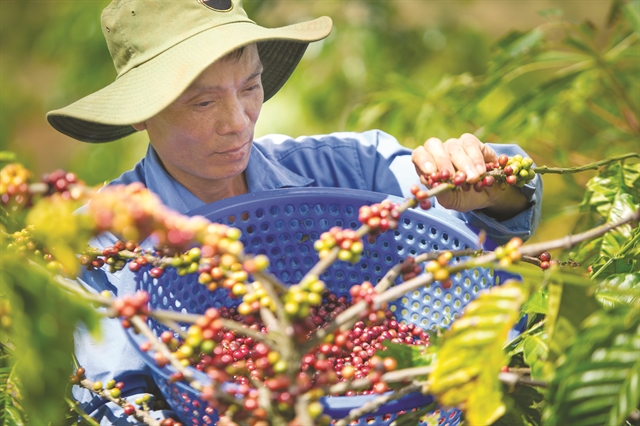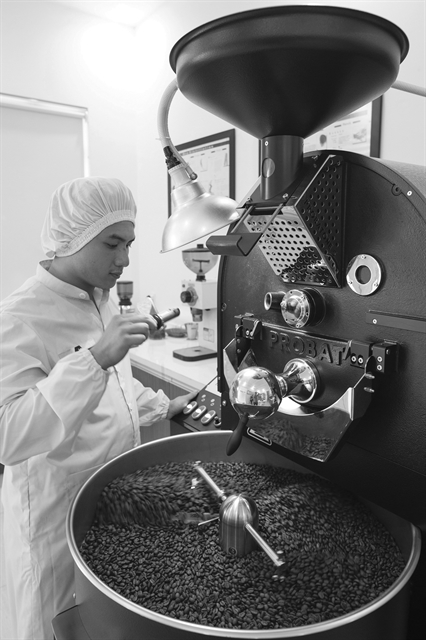
HARVEST: A coffee farmer in the Central Highlands province of Đắk Lắk. VNA/VNS Photo Nguyễn Luân
ĐẮK LẮK — Nguyễn Văn Trình is a farmer in the Central Highlands province of Đắk Lắk, where much of Việt Nam’s coffee is grown. For years, he has followed traditional cultivation methods, but has now switched to advanced practices for a higher quality bean that can be classified as “specialty coffee”.
Even though Việt Nam is the world’s second exporter of coffee, much of it is the low-quality Robusta bean used in instant coffee and other products. But Trình is growing high-end Robusta, considered even better than low-end Arabica, which is known as a higher quality coffee species.
The 39-year-old, who farms in Ea Tân Commune in Krông Năng District, discovered that older cultivation methods had been ineffective.
“Compared to traditional practices, newer practices are better, especially for organic cultivation. We pick only ripe pods and process everything right after harvest to ensure quality,” he said.
Trình, who left his hometown in the central province of Hà Tĩnh to move to Đắk Lắk in 1997, owns seven hectares of high-quality coffee trees intercropped with pepper and fruit trees.
"The demand for high-quality coffee is huge,” he said.

RIPE FOR THE PICKING: For better quality, selective harvesting is important, which means picking only ripe coffee fruit and complying with the drying and preservation process to retain flavour. VNA/VNS Photo Nguyễn Luân
Before the liquid stuff prized by millions worldwide gets to your cup, it has gone through five production steps: picking, processing, milling (hulling, polishing, cleaning and grading), storage, and roasting.
Selective harvesting, which means choosing only the best coffee pods and beans, is key to specialty coffee, according to Trình. The drying and preservation process is also important in retaining the flavour. “It's a must to throw away the bad beans,” he said.
“Many farmers in Đắk Lắk are now using organic fertilisers and manure without pesticides and fungicides," he said.
"This has increased the added value of coffee products, but all of this is easier said than done. We still face challenges at all steps, from productivity to output.”
Since 2015, Trình has invested VNĐ5 billion (US$215,480) in building state-of-the-art facilities for drying, seed processing, electronic sorting and storage.
“Now I’m able to provide 100 tonnes of high-quality coffee to the market every year,” he said.
In 2015, Trình established Ngọc Mai Quang Trung Co. Ltd, which produces a higher quality Robusta coffee than what is normally grown in Việt Nam. He has encouraged many households in the area to focus on specialty coffee.

GROUND: Roasting high-quality coffee. The production process includes picking, processing, milling, storage and roasting. VNA/VNS Photo Nguyễn Luân
Future for Robusta
Speaking at a recent coffee festival held in Buôn Ma Thuột, Manuel Diaz, a coffee consultant from Mexico, said that if Robusta beans were carefully selected at harvest and meticulously processed at the mill, it would have as many market opportunities as Arabica.
Because Robusta is naturally resistant to environmental stress and is highly adaptive, it can thrive more easily in areas affected by climate change, while Arabica is harder to grow and requires far more care.
However, Việt Nam has yet to reach the quality of other countries that produce specialty coffee, according to experts. Specialty coffee occurs when all of the people involved in the coffee value chain work in harmony and maintain a focus on standards and excellence from start to finish, according to Trình.
The term "specialty coffee" refers to the entire process “from farmer to cup using single origin coffee”, as well as how the coffee is roasted and extracted to make a cup of coffee, he said.
The American coffee pioneer and promoter, Erna Knutsen, writing in an issue of Tea & Coffee Trade Journal, first used the term specialty coffee in 1974 to describe beans of the best flavour produced in special microclimates.
According to the Specialty Coffee Association of America, coffee that scores 80 points or above on a 100-point scale is graded “specialty”.
Despite its small market share, which is about 2 per cent of total global coffee volume, specialty coffee has high added value, five to 10 times more than conventional coffee.
"Although Arabica has a reputation for higher quality, this is not always the case," Trình said. “The best specialty Robusta coffee will usually taste as good as or better than low-end Arabica. However, high-end Robusta isn’t widely consumed or available. Low-end Robusta is often used as a filler or cost reducer.”
Globally, Việt Nam is the second largest exporter of Robusta coffee, but the value of its products remains low. To improve the quality, the country should set stricter product standards, Diaz said.
Nguyễn Hải Ninh, chief organiser of the Buôn Ma Thuột Coffee Festival, said that specialty coffee earns higher profits. "We already have large coffee production and high export value, but we need to focus on this market segment to increase farmers’ incomes.”
Trịnh Đức Minh, chairman of the Buôn Ma Thuột Coffee Association, agreed that Đắk Lắk has great potential to produce specialty coffee, but a sustainable and long-term strategy is needed.
“It’s important to increase linkages between producers and buyers, and we need to create a specialty production chain and consumption at home and overseas,” he said.

NEVER BEAN BETTER: The Central Highlands province of Đắk Lắk has the largest coffee-growing area in Việt Nam with a total of about 204,000 hectares. VNA/VNS Photo Nguyễn Luân
Việt Nam now has about 50 specialty coffee producers.
“The northern area of the province, including districts in Krông Năng and Ea H’leo, with an altitude of 600-700 metres or more have many advantages to develop specialty coffee areas,” Minh said.
“These areas provide favourable conditions for both farmers and enterprises to focus on high-quality coffee and specialty coffee in the future,” he said.
Minh said that specialty coffee should be listed as a national high-quality product.
Tôn Nữ Tuấn Nam, former head of the Department of Science and International Cooperation at the Central Highlands Agriculture and Forestry Science Institute, said it was important to invest in harvesting and post-harvest preservation to increase value.
“Farming is facing challenges due to market fluctuations and climate change,” she said.
“Farmers, however, are now more aware of the importance of high-tech techniques, which can prevent pests and disease on coffee trees, and the need for irrigation solutions to cope with climate change.”
The biggest issue now lies in the stages of harvest and post-harvest preservation.
“Most coffee growers do this in a traditional way. They do not have the knowledge or the means for deep (or advanced) processing, which leads to output losses and lower quality, affecting value,” she said.
To increase quality, farmers need more support from businesses, especially investment in post-harvest technology, Nam added.
Long-term strategy
At the Buôn Ma Thuột coffee festival held in March, speakers at a conference noted that Việt Nam should focus on sustainable quality rather than increased output.
The coffee consultant from Mexico, Diaz, said that productivity and quality based on sustainable principles were both needed in Việt Nam.
“It’s also important to increase domestic consumption, and diversify crop structure and non-agricultural activities in coffee production areas.”
Minh of the Buôn Ma Thuột Coffee Association noted that specialty coffee played a role in improving the quality of the entire industry.
Leading coffee exporters, such as Brazil, Indonesia, African Specialty Coffee Association, all exploit this high-end market segment and promote their brands.
“The development of specialty coffee will help the industry enter new market segments,” Minh said.
To improve value, Đắk Lắk Province has issued incentives to support sustainable development of the industry. As a result, farming practices have been granted international certification from groups such as UTZ, 4C, Rainforest Alliance and FLO.
In addition, the ministry is implementing a project called High-Quality Vietnamese Coffee in the 2018-2023 period.
Việt Nam has more than 660,000 ha of coffee, mainly in Kon Tum, Gia Lai, Đắk Lắk (with the largest area, accounting for 36 per cent of output), Đắk Nông and Lâm Đồng provinces.
Last year, the country exported coffee to 80 countries and territories, earning more than $3.5 billion, accounting for 14 per cent of global market share, ranking second in the world after Brazil.
The top 10 export markets for Vietnamese coffee are Germany, the US, Italy, Spain, Japan, Belgium, Russia, Algeria, the Philippines, and China.
Despite high export prices, Vietnamese coffee exports are growing only 6.57 per cent per year because of low added value and fluctuations in the global market.
But with the new emphasis on high-quality specialty coffee, farmers and enterprises are hoping that the transformation of the industry will lead to higher prices and improved incomes as well as sustainable production. — VNS
OVietnam